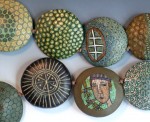The Collection: Part 1
On the wish list of the Museum of Fine Arts, Boston, MA
Elise Winters, Citron Cascade RUFFLE, neckpiece, 2009
Over the past few months PAA readers may have noticed posts on different pieces that Elise Winters titled, “Selection from the Collection.” Aside from being a catchy sounding phrase, what does this really mean? The explanation entails a step back in time, so please follow along. There is an exciting ending.
On the wish list of the Racine Art Museum, Racine, WI
Victoria Hughes, Souvenir, 1997
Before I was really aware of what was what with polymer, Elise Winters already had a vision. She wanted to educate serious craft collectors and curators about the best polymer art. This lead to MIPCES– an invitational exhibition and sale as well as a series of related educational events all held in May, 1997. MIPCES was an unequivocal success, introducing many artists and their work to an audience beyond the polymer enthusiasts.

On the wish list of the Museum of Arts and Design, New York, NY
Cynthia Toops, Billy by the Riverbank, necklace, 1995
Several years later, Elise was again thinking about the long term picture. At the NPCG Courting the Muse conference at Bryn Mawr College in June 2001, she was asked to put together a small exhibition. She decided to mount an exhibition showing a historic survey of polymer as an art form. By this time we knew each other and I became part of the team that coordinated a small show of “polymer art” history. While incomplete in many areas, the exhibit presented an evolution of the medium from some of its earliest examples in the mid 1980’s to then current pieces. Because of my art history background, I became the historian for the exhibit and assembled a slide show to document the event for the guild.
On the wish list of the Newark Museum, Newark, NJ
Kathleen Dustin, Tornado Cuff, bracelet, 2005
And then, a few years ago Elise called me. The call was not unusual since our conversations had become routine, but as she proceeded to explain her latest idea for recording a written history of the medium, I quickly realized Elise was thinking ahead again. Although we had often discussed the need to publish a definitive history of polymer, publishers felt that the market place was not yet ready for such a book. Cynthia Tinapple thought the information should be available as quickly as possible. She convinced Elise to consider a blog. Cynthia explained how a website or blog would be a far more accommodating means of noting information. A website would be flexible and could expand infinitely as the information was gathered. This was the origin of the Polymer Art Archive, which you now are reading.
On the wish list of the Philadelphia Museum of Art
Jeffrey Lloyd Dever, Ephemeral Muse, neckpiece, 2009
We knew that the presence of written documentation for polymer art was an important step towards a broader recognition of the medium. Without documentation there is no means of verification. And without some kind of verification, it is more difficult for polymer to gain acceptance as a serious medium.
Elise and I talked about what the archive site should and could do. We agreed that there ought to be several independent sources in agreement before recording something as fact. As a medium, polymer needed an historical foundation of knowledge beyond the technique based information available through workshops, books, magazines and the internet. The polymer archive site would document significant events and whenever possible have artists write first person recollections of what had happened. True to her determination and style, Elise also mastered the computer skills necessary to make this happen. The PAA was launched late in December of 2007.
On the wish list of the Mingei International Museum, San Diego, CA
Nan Roche, Vessel, 1997
However, as it turned out, the PAA was only one part of what had become a far more extensive project. The next goal was to entice an established and yet forward-looking museum into acquiring masterful works of polymer art for its permanent collection. It was time for polymer to move beyond its early incarnation as a hobbyists’ material, and claim its place as a stimulating and recognized artistic medium.
What might be done to spark the interest of a museum curator? Initially, a curator has to made aware that there is a need or hole in their permanent collection that should be filled. And then, once they’ve acknowledged that need, present a ready solution to their problem in a way that won’t overly tax the museum’s budget or overwhelm its staff. Elise was prepared to make a two-part offer: first, to gift the museum with donations from a private collection, and then to provide the funding that could help to support a future exhibition, an exhibition catalog, or even offset the significant expenses of taking in an extensive acquisition.
Elise knew that she had the beginnings of a museum-quality assemblage of works within her own private collection of polymer art. And after she explained her donation concept to three other independent collectors of historic polymer works, Nan Roche, Lindly Haunani and Carol Watkins all decided to become part of the effort. Together their four collections comprised over a thousand art works that Elise would be able to call upon in order to attract the attention of museum curators from Massachusetts, New York, New Jersey, Wisconsin, Texas and California.
“The Polymer Collection Project” was transitioning from an abstract concept to a quickly developing reality. Lots of work still to be done….
(More information on “The Collection Project” in the next post.)




